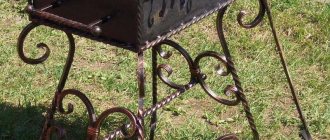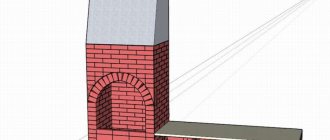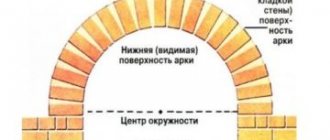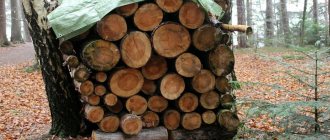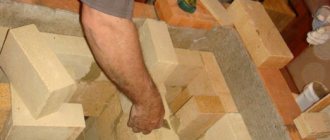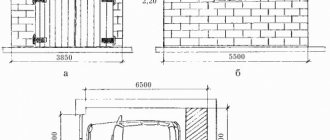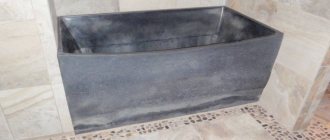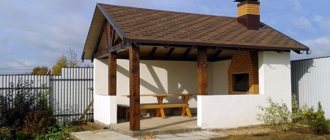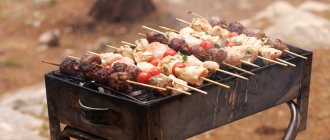Where to start construction
Now the time has come to replace the old metal barbecue grill for the dacha with a good-quality brick grill.
You already have a rough idea of what it will be like. This could be a low table with a brazier or a solid structure that combines all kinds of cooking utensils.
The grill can become a central building, spreading the aroma of barbecue from the center of the site, or separate your dacha from the neighbor’s with a reliable wall.
Barbecue grill located in the center of the site
At this stage you need to decide:
- what functions should it perform,
- where it will be located: outdoors, veranda or in a gazebo.
If you like to cook a lot and variously, gathering large groups around, a complex with a barbecue, a stove for a cauldron, a smokehouse, a sink and other devices installed under the roof would be a good choice.
Minimalists who prefer to quickly cook dishes on skewers or a grill will opt for a simple-design barbecue grill.
Grill supports
Between the fifth and seventh rows you need to attach metal plates; they will hold the grill for cooking meat.
The optimal location is along the walls located on the sides, at a distance of 9 to 66 cm from the back of the building.
Scheme, drawing, project
The project with a drawing of a brick grill is ready! You can start building
Projects large and small begin with a simple diagram drawn on paper. You need to figure out:
- approximate overall dimensions of the entire structure - they will be a multiple of the size of the brick;
- position of the main elements;
- their sizes.
For a small barbecue, it is enough to sketch out the proposed pattern and follow it, not forgetting about the dressing between the rows. The dimensions in a drawing made independently may change slightly during the laying process depending on the brick used, the thickness of the seam and the embedded elements.
Banding is a method of laying bricks in a row relative to the previous row, usually by half a brick.
For more complex structures, a detailed project is developed based on the diagram, where all the nuances are taken into account. To lay a brick barbecue with your own hands, make up barbecue orders - diagrams for laying bricks in each row.
Operating rules
The stove will last a long time if you care for it properly. Clean the grates of dirt after each frying, and the chimney at least once every six months.
It is important to follow fire safety precautions:
- control the intensity of the fire;
- do not allow flammable objects near the heat;
- Do not use gasoline or kerosene for ignition.
To avoid gradual destruction of the structure due to sudden temperature fluctuations, before using in cold weather, the device must be dried over low heat for 15 minutes.
Assembling a barbecue with your own hands according to drawings and photos will not require much effort if you follow the step-by-step instructions.
The store, of course, sells outdoor ovens, but dishes prepared on a personally built structure will seem even tastier, and your heart will be filled with joy for such independent work.
Choosing an installation location in a country house or plot
A barbecue grill is a stationary building that cannot be moved to another location. It fits into the site and becomes one of the main functional and decorative elements of the landscape. Therefore, it is important to choose a convenient place for it in advance.
Convenience of location
The location of the barbecue on a personal or summer cottage should, first of all, be convenient for use. Usually a path is laid to it and a resting place is arranged.
To prevent smoke from interfering with cooking and relaxation, it is necessary to take into account the direction of the wind that prevails in the area and locate the grill on the leeward side. If you choose a place too close to the house or summer kitchen, the smell of cooking dishes will linger into the house, but you won’t have to go far for various little things. If you are away from home, it’s the other way around. Usually, owners find a middle ground, preferring criteria that are more important to them.
You should not place the barbecue adjacent to the neighbor’s property. The smoke and smell of a fire does not delight everyone. What if the neighbors came to their dacha to get some fresh air?
Technical requirements
You should not place the barbecue in a wetland or constantly wet due to watering, because the brick structure will absorb moisture and collapse faster.
Constant moisture will cause the brickwork to deteriorate more quickly.
When installing a brick grill with your own hands, you also need to remember that this is a source of fire hazard. Sparks or fallen burning coals can cause fires in nearby flammable materials, trees or buildings.
When placing a barbecue on the site, you need to remember that this is a source of fire hazard
Therefore, it is recommended to follow the safety rules:
- choose an open place;
- the distance to trees, buildings, and parking areas must be at least 5 meters from an open fire, from the walls of the barbecue - 0.5 meters;
- do not store flammable items nearby;
- lay concrete tiles, stones, paving stones or other non-combustible covering around.
Covering with paving slabs for the construction of a brick barbecue with your own hands
Operating principle and advantages
The word barbecue (from the French, abbreviated BBQ) means roasting meat over a “live” fire or coals. This is also the name of a device that works using this method and combines all the advantages of a barbecue, smokehouse and grill.
In addition to steak, you can use it to fry wings, sausages, smoke seafood, bake fish or vegetables. The stove can handle drying berries and mushrooms. You can cook pilaf and even soup on it.
All these numerous cooking methods are possible due to the design features, consisting of the following parts:
- Box with back wall. Thanks to the high sides, heat is not blown out and the required temperature is maintained inside the container. Therefore, frying is carried out without the risk of drying out and burning the food.
- A tray for coals, which is located in a special safe firebox.
- Grids for products.
Many products have a chimney to make it comfortable to cook or have a picnic nearby. If you install such a fireplace in semi-closed gazebos or terraces, it will heat the room.
Foundation
A stationary brick grill definitely requires a foundation, which is due to the significant weight of the structure. A reliable foundation is necessary even for a small grill if you want it to look presentable and serve for a long time without subsidence or cracks.
Work algorithm:
- Using a tape measure, pegs and cord, we mark the place according to the dimensions chosen in the project.
- We remove the turf and dig a hole 30-35 cm deep.
- Fill one third with sand, compact it, water it, tamp it.
- Add the same layer of crushed stone with sand in a ratio of 3:1.
- We waterproof the walls by laying roofing material so that it protrudes 10 cm above ground level.
- We construct formwork around the perimeter from boards or timber with a protrusion of 5-10 cm above ground level.
- We lay the reinforcing mesh.
- Fill with a solution of cement, sand and gravel, prepared in a ratio of 1:2:4.
The foundation must be poured in one go so that the slab is monolithic and does not crack.
After pouring, do not rush to erect a brick structure. The foundation should dry evenly and harden after standing for at least 2-4 weeks. During this time, you can cover it with film.
Ready foundation for barbecue
Creation of the focal part
The tabletop is laid on the created plinth. A concrete slab is ideal for this. If you don’t have it, then you can make such a plate yourself:
- Along the perimeter of the upper part of the plinth, formwork is installed, created from scraps of plywood or wood. Its height should be equal to the thickness of the slab.
- An OSB sheet or thick plywood is placed on the bottom. Everything is laid in such a way that the area of the opening between the walls of the basement is completely covered.
- The bottom of the formwork is evenly filled with a layer of mortar 15-20 mm thick. A reinforcing mesh is placed on the frozen mortar and again filled with mortar to the very top.
- The formwork is removed only after the concrete has completely hardened. This may take several weeks.
Only after this can you start making the hearth. During work, a mortar for laying stoves and fireclay bricks are used:
- To obtain a plastic solution, you need to soak the clay in advance. In this case, it should be soaked for several days. Brick should also be soaked for at least a day.
- Sand is added to the clay and the mixture is mixed until it resembles a thick dough.
- Brick laying is carried out in such a way that the hot coal does not reach the concrete slab.
- The front wall should have a thickness of about 300 mm and a height of 500 mm. To allow air to enter the barbecues, several small holes can be made in the walls.
Tips for building brick grills
- Laying begins from the corner. During work, it is important to check the verticality of the walls using a plumb line and level.
- The outer part of the barbecue grill is made of ceramic brick, and the firebox and chimney are made of fireproof fireclay. Sheets of basalt cardboard are placed in the gap between the firebox and the lining.
- Bricks should be soaked in water before use, especially if you are a novice mason. Wet brick will not absorb moisture from the mortar too quickly, which will help you complete the laying more slowly and with better quality.
- To try on, the row must first be laid out without mortar, and then laid out with mortar.
- When laying a large structure, to increase strength, craftsmen recommend laying a reinforcing mesh after every third row.
How to lay out bricks for a barbecue and oven first without mortar
Second phase
In order for the top covering to lie evenly, sand is required; after pouring, using a level, the future foundation is laid out, on which beautiful stoves in the country will stand.
If the choice falls on the foundation, it must be reinforced. A rod with a diameter of 10 mm is suitable, available for sale at every metal construction base.
Chimney device
When the chimney continues to be laid out of brick, the order of work is as follows:
- The top of the combustion and facing parts are brought out to one level.
- To lay the smoke collector, a solid brick is taken. The solution is cement-sand. Cement grade – from M150.
- The first row is flush with the inside of the firebox. All subsequent ones are shifted by ⅓ of the brick.
There is no need to shift it over a greater distance, otherwise the bricks will simply fall inside the firebox over time.
- The laying is carried out until a small opening remains (30*30 cm, 25*25 cm).
- The finished brick chimney is covered with a protective cap on top to prevent moisture and precipitation from getting inside.
There is an option for mounting a chimney made of heat-resistant concrete or a double-circuit chimney made of sandwich pipes.
Read step-by-step instructions for installing a chimney made from sandwich pipes.
Finally - very simple stove options
We intentionally recommended immediately building a serious garden barbecue complex, since a universal oven is of greater interest to customers. If you manage to build a similar barbecue out of brick, then adding bedside tables, a smokehouse, and even building a fireplace will not be a serious problem.
Instead of a permanent structure, you can create the usual structure shown in the photo. There is no need for mortar, and no foundation is required: just buy a ready-made barbecue grid and lay out a brick bedside table according to its dimensions. To prevent the structure from collapsing, choose an ideal solid site.
The simplest barbecue with a smoke collector is built in the form of two retaining walls on a cement-sand mortar. To install the brazier, a monolithic concrete slab is cast (or a ready-made one is used). An alternative option is to tie the brick walls together with a frame of corners. The umbrella for collecting smoke is made from ordinary roofing steel.
Preparation of the solution
The main components of the masonry mixture are clay and sand. The recommended proportion is two parts sand to one part clay. The day before mixing the solution, the clay is soaked in water.
An important feature of clay is that the fatter it is, the greater the sand consumption.
If the consistency is correct, the solution will slide off the trowel, leaving a small mark on it. If it falls off without any traces, then a lot of sand has been added; on the contrary, it smears a lot - there is an excess of clay in the mixture.
For laying the main parts, cement is not added to the mixture due to low heat resistance. But it is permissible to cover the grill with facing material using cement mortar.
What you will need
The following can be noted from the tool:
- Trowel for applying the mixture.
- Rubber hammer.
- Water level.
- Plumb.
- Saw for cutting bricks and a set of discs.
- Grinder with cutting and grinding wheels.
Without neglecting all the preparatory work and adhering to a clear plan of action, each owner will be able to boast of a multifunctional and beautiful building.
Video description
The video shows how to properly organize when assembling a brick grill:
Corner brick grill with firewood under the brazier Source dengivezde.biz
If the project includes a support wall, that is, if it is planned to raise not the back wall, but the cabinet, to the brazier, then you can do without a metal profile. For example, the photo above shows an option in which there is a firewood niche under the brazier. In such a design, you will have to use a steel corner on which the bricks of the bottom of the brazier will rest.
Pay attention to the same photo. It clearly shows that the niche for the firewood has an arched vault. This design makes it possible to avoid the use of metal profiles. On the one hand, the less variety of building materials, the better. But on the other hand, an arched vault is a complex structure that requires experience, skills and knowledge of the correct masonry.
The photo below shows part of a corner barbecue grill at the stage of constructing a brazier. Please note that between the bottom niche and the top there are two rows of bricks that lie on a steel angle. This is very clearly visible. This is exactly what was discussed above.
Steel corner between the brazier and the lower niche of the stove Source pinterest.com
Features of brickwork
The construction of fireplaces, stoves, barbecues and barbecues, that is, structures in which open fire is used, are built according to the same rules. Here are the main ones:
- the firebox or brazier is built from fireclay refractory bricks ;
- for masonry they use a special fire-resistant mixture , which today is sold in all construction stores in paper bags and sacks;
- Ceramic bricks are used to construct the entire structure ;
- masonry mortar thickness – 3-4 mm;
- Between fireclay and ordinary bricks, a masonry mortar up to 6-13 mm thick is laid, which compensates for the thermal expansion of materials of different densities.
Furnace configuration
In any type of stationary furnace, it is necessary to have a reliable foundation, which will ensure long service life.
You should also be responsible when choosing fuel. It is unacceptable to use firewood from coniferous trees, resinous fruit trees (plums, cherries), lumber impregnated with resin.
To ignite, take matches and a special liquid. It is prohibited to use gasoline or kerosene to create a flame. There will definitely be no benefit from adding such components to food. But it can cause harm to health after consumption.
Simple design
Such buildings are often used in summer cottages. This is the most popular option for homemade structures, as they do not require in-depth knowledge of masonry techniques.
To protect against rain, it is recommended to supplement them with a dome-shaped smoke collector. For ease of use, a medium-sized tabletop is built in. The optimal building material is fireclay brick. Fuel – charcoal, firewood.
Photo: small barbecue with a rain cover
If you follow the step-by-step masonry technique, the fire will not come into contact with metal elements, which means that the walls and bottom will not burn out and the grill will last many times longer.
Such designs do not have holes for air access, which significantly saves firewood. They do not burn out quickly, but smolder.
The finished grill will not take up much space on the estate. This is a budget stove for seasonal use.
With smokehouse
Standard factory kits of fire-resistant brick barbecue stoves do not include a smokehouse. It can be purchased additionally if the product model includes a built-in wood-burning stove.
The smokehouse is made of stainless steel sheets with a thickness of 2 mm. Inside there are 2 levels of grates on which products for smoking are placed. Equipped with a groove for a water seal. If water gets in, the tightness of the shutter prevents smoke from escaping.
Layout diagram of a compact barbecue
The smokehouse is attached to the place where there should be a stove or cauldron on top of the stove. To start the device, the VFS (built-in wood stove) is ignited. Wood shavings smolder inside the smokehouse and hot smoke begins to form.
With cauldron, stove
A cauldron with a stove can be equipped independently with a built-in wood-burning stove or be part of a barbecue complex, complemented by a countertop and sink.
A red brick grill is laid out. The side, rear and front brick walls form the oven chamber. From the outside of the structure, only the firebox door and the ash pan handle are visible. At the top of the stove there is a round hole for a cauldron or stove, at the bottom there is a grate, an ash pan that extends.
Built-in wood stove - source of heating for the cauldron and stove. For the firebox, it is better to take firewood and chipboard briquettes.
The complexes are equipped with an 8-liter cauldron, but it is possible to install containers with large dimensions up to 12 liters.
The chimney is made from a double-circuit sandwich pipe of rectangular cross-section. The upper part of the pipe is discharged into the smoke collector.
With grill, barbecue
The usual grill shape is a deep, round frying pan with a barrel-shaped lid. If the lid is closed, the food is cooked evenly on the sides, bottom, and top.
Barbecue differs from grilling in that the product is fried only from below, and not from all sides. This is due to the lack of a lid.
The inside of the device is very similar. The main detail is the gratings. Fish and meat are laid out on the top grate, fuel is placed on the bottom grate. For comfortable cooking, the upper grill can be adjusted to 3 positions.
Unlike a barbecue, the grill has openings with dampers so that air access can be regulated.
There is a retractable ash pan where ash and ash accumulate. Many factory models are equipped with a spit and folding table. There are grills with double clamping grates.
Before the first use, the grill or barbecue is thoroughly lubricated with vegetable oil, pierced and allowed to cool.
With canopy (roof)
Photo: garden grill with a canopy made of metal and polycarbonate
A covered canopy is an excellent protection from precipitation, especially in winter, when the water begins to freeze and melt. It is recommended to assemble the canopy from fireproof materials - metal racks and corrugated sheets, metal tiles.
If it is not possible to build a shed, then it is necessary, at least temporarily, during the period of precipitation, to cover the grill with thick plastic film.
Precipitation falling on the structure at an angle will not cause harm.
Angular
This barbecue design is becoming increasingly popular. Placing the device along the walls, adjacent to the corner, allows you to significantly save space. This is especially true for small summer cottages and gazebos.
The requirements for materials are unchanged - moisture resistance, fire safety.
Corner placement is an excellent option for barbecue complexes, where it is convenient to place a tabletop, sink, niches for firewood and utensils on the sides.
However, such a structure cannot be built by beginners. It requires competent calculations and knowledge of masonry techniques, so it is better to invite a specialist.
Fireplace-barbecue
Interesting type of combination. The fireplace is:
- built-in;
- free-standing.
The built-in fireplace is an element of the barbecue complex. The fireplace module is installed instead of a barbecue or vice versa.
When using a fireplace insert, a large load of firewood is allowed at one time. It is carried out into the firebox. When installed indoors, the fireplace barbecue will become a source of heating in cold weather.
With countertop, sink
The working surface of the tabletop is built-in or can be placed separately. Collapsible models are available.
Installation is carried out on the left or right side (at the discretion of the owners).
It is necessary to determine the location at the stage of developing sketches, so that the factory can make a high-quality product that will be closely adjacent to the structure.
By adjusting the length of the tabletop, the complex can be adjusted to specific room sizes.
Equipping the complex with a sink simplifies and makes food preparation comfortable. For installation, attention is paid to the correct water supply and sewerage.
Barbecue complex
Multifunctional design. Difficult to build on your own.
It has several departments:
- built-in wood stove;
- plate;
- oven;
- barbecue;
- B-B-Q;
- smokehouse;
- cauldron;
- spit;
- tabletop.
The set of elements differs depending on the model.
It can be installed both for outdoor use and in closed buildings such as a summer kitchen or gazebo. With the right choice of material for cladding, it looks very beautiful.
Users often search for:
- How to make a patio
- Vertical barbecue grill
